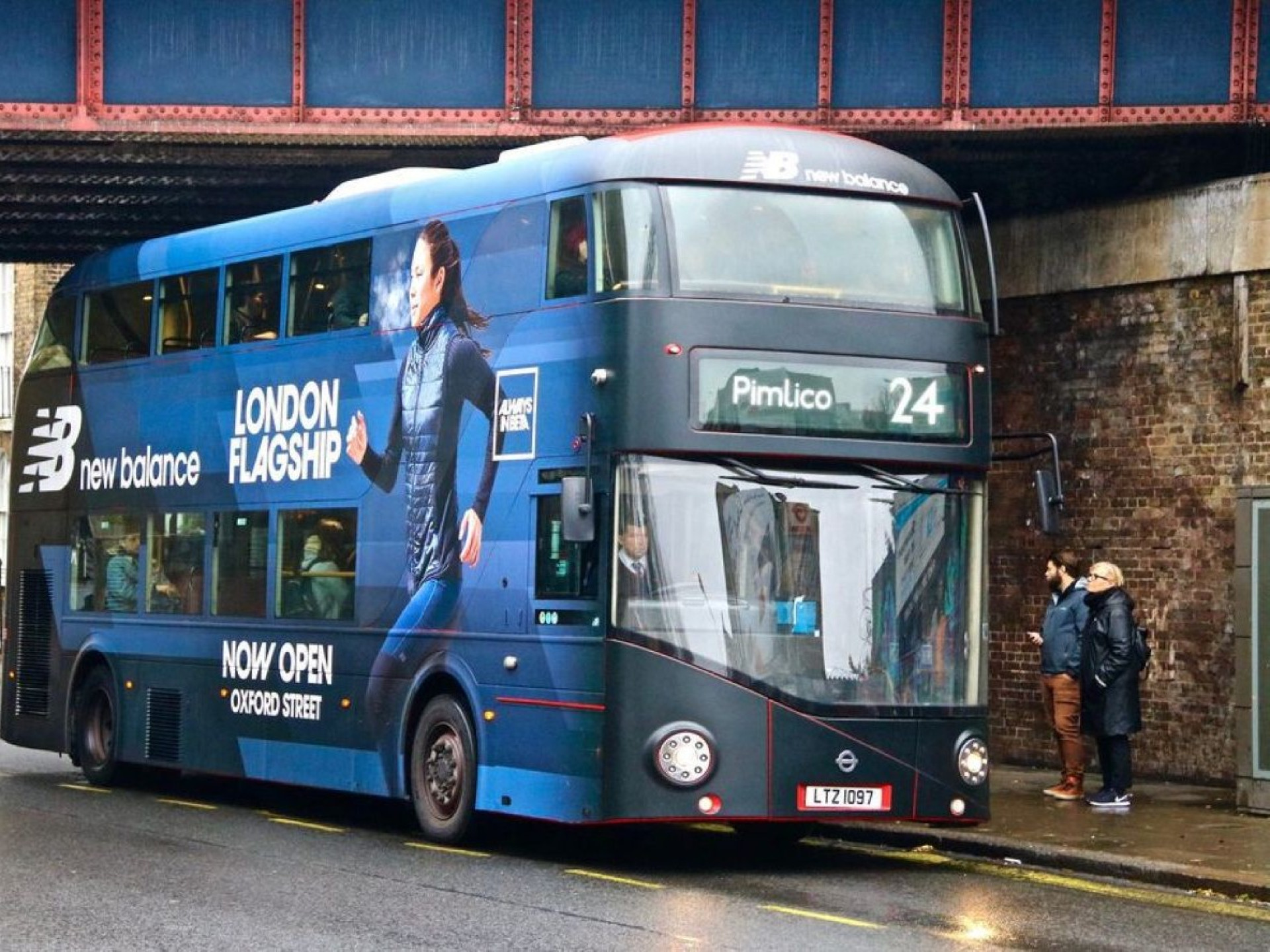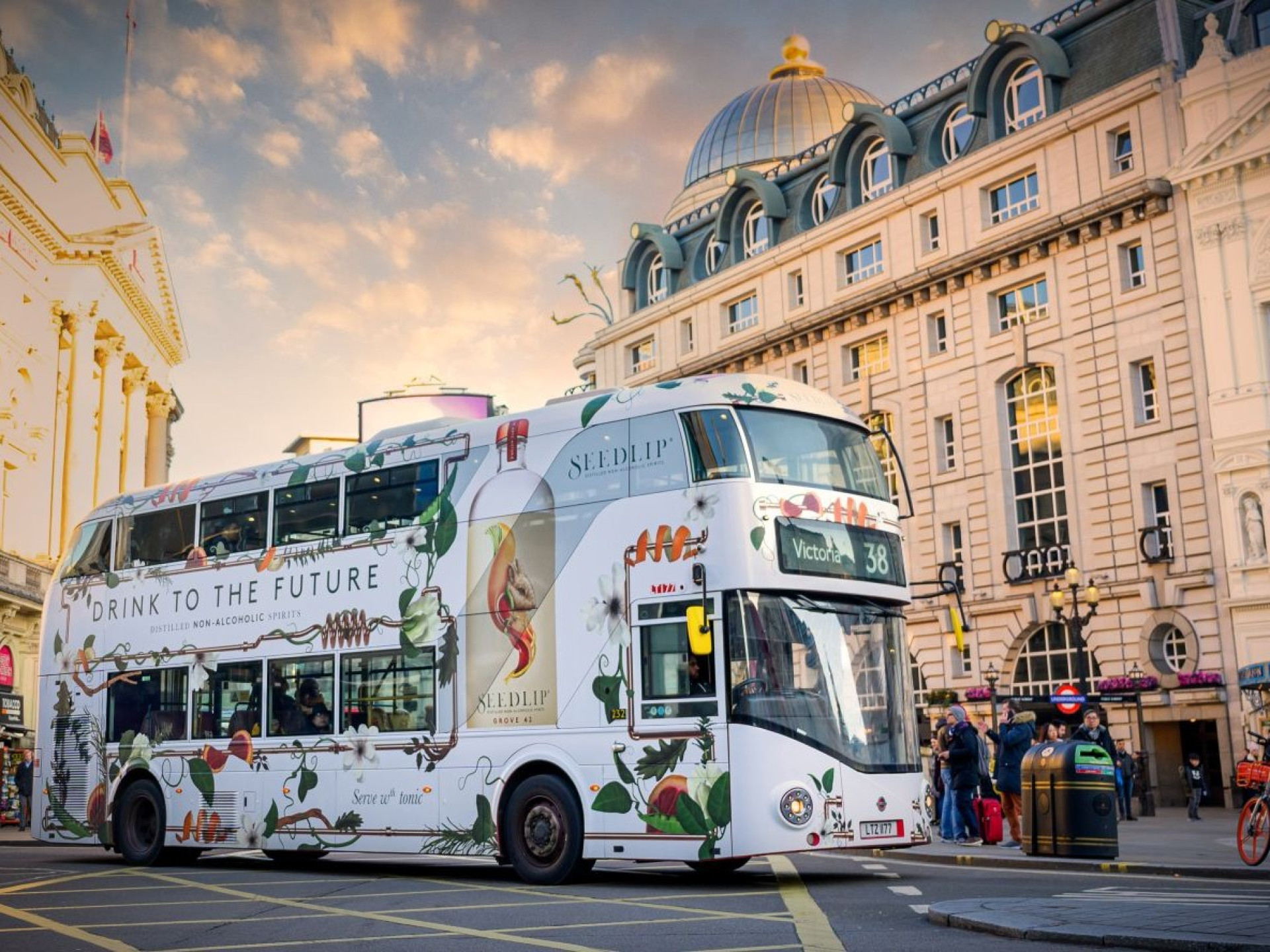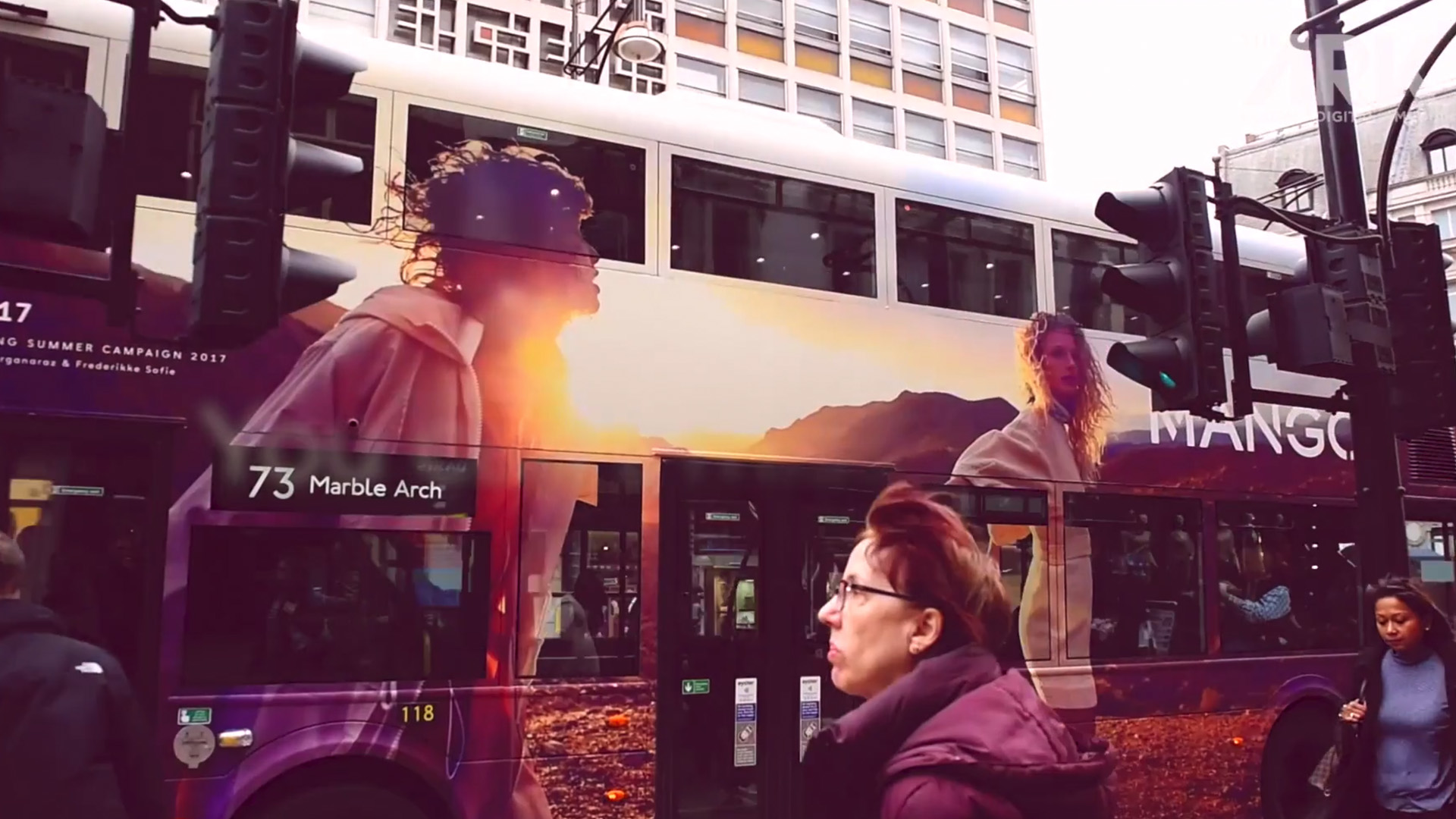Use Bus Advertising to Transform Your Brand's Visibility
Stop blending in. Stand out, captivate audiences, and achieve unmatched visibility with our proven bus campaigns.
Buses are flexible advertising media, meaning that whatever your campaign objective, a bus can deliver it. By its nature, bus advertising is unmissable. Consumers don't have to "turn it on", "download an app", or "turn over the page" to see it, meaning that 94% of the population sees bus advertising. (Source TGI)
Bus Exterior Advertising
Buses are incredibly versatile advertising media, capable of meeting any campaign objective. By their very nature, bus advertisements are unmissable; consumers don't need to "turn it on," "download an app," or "turn over the page" to see them. This results in 94% of the population being exposed to bus advertising. As the UK's most-seen media, bus advertising offers unparalleled reach and brand mileage, whether for local, regional, or national campaigns. Buses are hard-working and highly effective, averaging over 100 miles per day. Their constant movement draws attention and ensures your advert is seen frequently throughout the day by a diverse and ever-changing audience, from early morning commuters to midday shoppers and evening socialisers. Bus advertising is omnipresent, reaching pedestrians, motorists, and commuters alike.
Bus advertising reaches audiences when they are in a receptive mindset, leading to high levels of engagement, with over 80% of people who see bus advertisements responding to them. Another significant advantage is that 74% of people believe buses are a valued and important part of the community, allowing businesses that advertise on them to build a positive relationship with the local population. This community connection enhances the effectiveness of bus advertising, making it a powerful tool for brands looking to increase visibility and foster positive public perception. By leveraging the extensive reach and high visibility of bus networks, businesses can effectively communicate their message and engage with a broad audience, driving both brand awareness and customer engagement.
Bus Advertising Frequently Asked Questions
Can I advertise on specific buses in a specific area?
Bus advertising is available in almost every city, town or village in the UK. You can’t advertise on a specific bus route number. However, you can advertise on buses that cover a specific geographical area.
How much does it cost to advertise on a bus?
The cost of bus advertising varies depending on the format of the advert (mega rear, t-side, wrapped bus or single deck sides), the number of buses and the duration of the advertising campaign. Our bus media specialists know how to create strategic bus advertising campaigns that will deliver your brand and message to a targeted audience, quickly and inexpensively.
Is it effective to advertise on a small number of buses?
Our advice on local/geo-targeted campaigns is to take a high or medium share of bus advertising in your chosen geographic areas. It is vital to ensure that the correct share of voice is achieved in order for your campaign to be effective. It is much more effective to go big in a small area than small in a big area.
Is bus advertising effective?
Bus advertising is highly effective when done well, giving you the greatest reach and brand mileage. It is ever-present whether you are on foot or in a car. Bus advertising is a cost-effective way to deliver an impactful message to your target audience, constantly reminding them of your business/brand.
Bus advertising effectively delivers results, whether it’s about driving sales online or in-store, generating new revenue by retaining existing customers or acquiring new ones. It offers high levels of response with over 80% of people who see bus ads responding to them. (Source Route)
What bus advertising formats are available?
Bus advertising is available in several formats. Exterior bus adverts are available on the side or the rear of the bus, depending on who you want to target. Take a look at each format to see the benefits.
How can I measure how effective bus advertising is?
Using our planning technology systems, we can provide you with predicted campaign delivery results, showing how bus advertising can play an integral role in building brand awareness, broadcasting your message and driving traffic to your website.
How do you advertise on a bus?
- Select the cities/towns that you would like to advertise in.
- Look at the available bus ad formats and select your preferred options.
- Calculate your budget.
- Think about your start date and the duration you would like the campaign to run for.
- Contact our experts who will help plan your campaign in the most effective way to reach your target audience within your given budget.
How many people will see my bus advertising campaign?
We use Route, the independent industry audience measurement provider, to give us a calculation of the number of people who will see your bus advert, the number of times they will see it, and where they will see it.
Watch our quick 2-minute video which explains in more detail how Route works
How Many People And Impacts Will Your Outdoor Advertising Campaign Have?
Bus Rear Advertising
Bus rear ads are both eye-catching and impactful, providing an unparalleled presence in city centres while fitting within various budgets. As the highest-reaching format, bus rears can get your message across to nearly 71% of the UK population in just two weeks. On average, these ads have a 48-second 'dwell time,' allowing consumers ample time to absorb your message. This extended exposure, combined with buses crossing city and town centres up to 16 times a day, seven days a week, ensures that bus rear ads encourage direct responses and enhance brand recall. By driving consumers directly to your website, bus rear ads can save you money on pay-per-click advertising and boost your search engine optimisation traffic, strengthening your brand's online presence. This makes bus rear ads a highly effective tool for reaching a broad audience and driving engagement.
Bus rear ads are highly effective for reaching both motorists and pedestrians. With motorist impacts at 65%, bus rears are the only bus advertising format that sits directly in front of drivers, providing unmatched immediacy on the road. The size of a bus rear ad is perfect for fitting a motorist’s windscreen, ensuring that your campaign captures attention effectively. This format acts as a moving billboard, commanding attention on busy streets and highways. By leveraging the strategic placement and high visibility of bus rear ads, businesses can effectively communicate their message to a broad audience, driving both brand awareness and customer engagement. The constant movement and prominent positioning of bus rear ads make them an ideal choice for businesses looking to maximize their marketing efforts and achieve significant results.

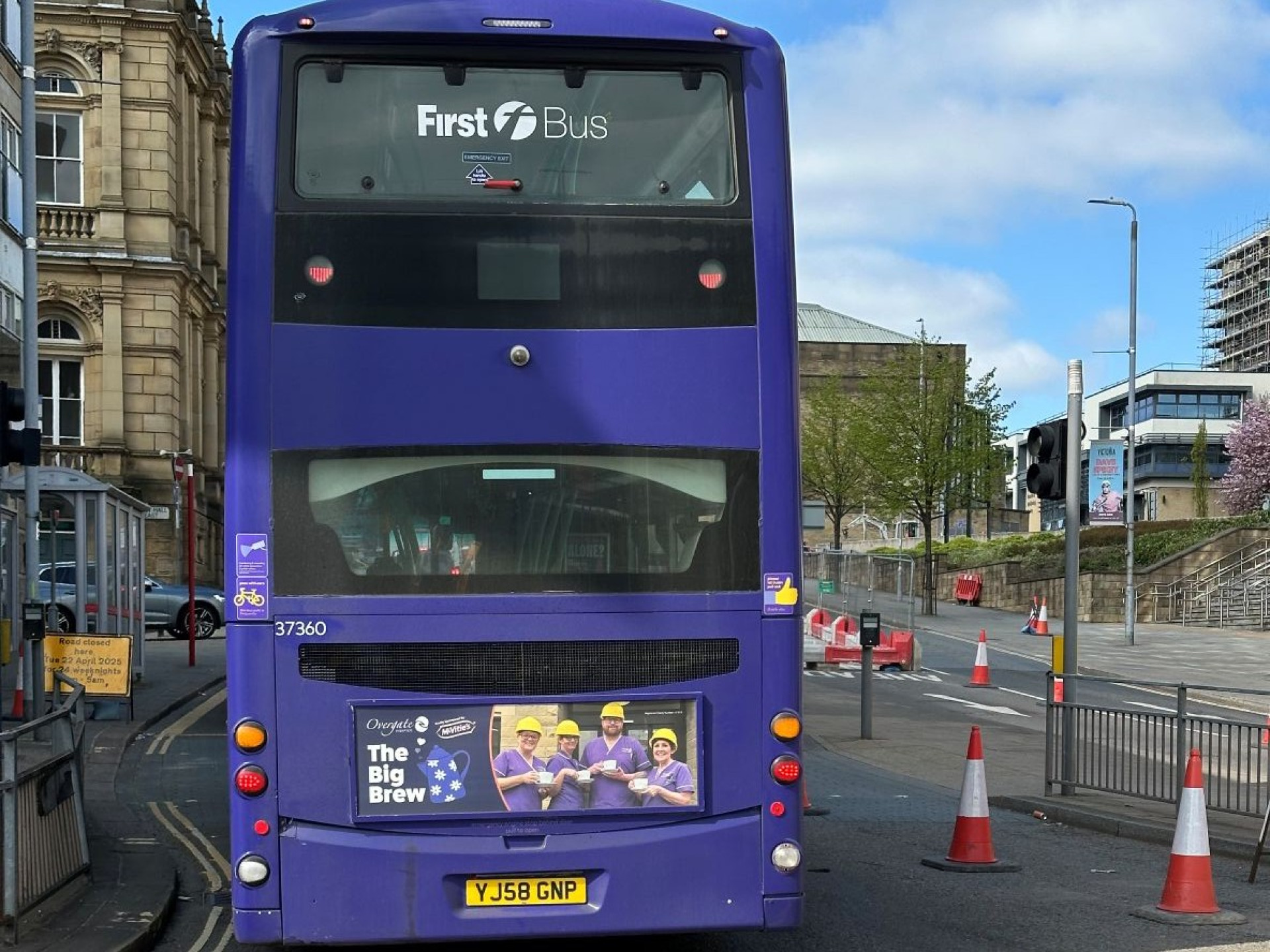
Bus Rear Panel Frequently Asked Questions
How do you advertise on the back of a bus?
Here are 5 short steps to help you…
- Select the cities and towns that you would like to advertise in.
- Calculate your budget.
- Think about your start date and the duration you would like the campaign to run for.
- Consider your target audience.
- Contact our experts who can help you decide which bus routes will reach your audience, how many bus rears you will need to run an effective campaign and how best to design your advert in order to have the greatest impact.
How much does it cost to advertise on the back of a bus?
Bus rears provide great value for money. At £208 per panel (rate card) for 4 weeks, they’re one of the most cost-effective broadcasters in OOH, with a national campaign having a cost-per-thousand of just £3. We have some fantastic volume offers when you book a campaign running over 8 or 12 weeks.
Can I advertise on bus rears in a specific area?
Bus rear advertising is available in almost every city, town or village in the UK. We select buses based on the routes that they take on a daily basis. You can’t advertise on a specific bus number however, you can advertise on buses that cover a specific geographical area.
Is bus rear advertising effective?
Bus rear advertising is highly effective when done well, giving you the greatest reach and brand mileage. Bus rear advertising is ever-present whether you are on foot or in your car and is a cost-effective way to deliver an impactful message to your target audience, constantly reminding them of your business/brand. Bus effectively delivers results, whether it’s about driving sales online or in-store, generating new revenue by retaining existing customers or acquiring new ones. Bus rear advertising offers high levels of response with over 80% of the people who see bus advertisements responding to them. (Source Route)
Bus Side Panel Advertising
Are you seeking a powerful way to promote your brand and reach a wide audience? Utilising options like Single-Deck Sides for local messaging and Double-Deck Sides for urban visibility, your message can travel far and wide. These formats ensure that your brand is seen by a diverse and extensive audience, maximising your reach and impact.
Double-Deck T-Sides can elevate your campaign to the next level. By leveraging the movement and high visibility of buses, you can drive consumer action like never before. This dynamic approach ensures that your brand remains in the public eye, creating lasting impressions and encouraging engagement. Read on to discover how we maximise the potential of each format to achieve outstanding results.
Single Deck Sides
Single-deck buses are vital to suburban routes, keeping local communities connected and making them ideal for localised messaging. These buses also navigate busy city centres, ensuring that your campaign reaches active shoppers and commuters. On average, a single-deck bus travels over 100 miles daily, making it the workhorse of the bus family. A two-week national single-deck side campaign can reach 79% of all adults, providing each adult with an average of nine opportunities to see the advert, according to BusAds. This extensive reach makes single-deck side advertising a cost-effective way to communicate with your target audience on a street level.
Single-deck side adverts, typically 10ft or 13ft, demand the attention of both drivers and pedestrians, engaging consumers at eye level and giving them ample time to absorb your message. Unlike other advertising formats, single-deck side adverts are always on; they can't be turned off, switched over, or thrown away. With single-deck buses on the road an average of 16 hours a day, 7 days a week, your brand message receives maximum exposure, ensuring it remains in the public eye and creates lasting impressions.
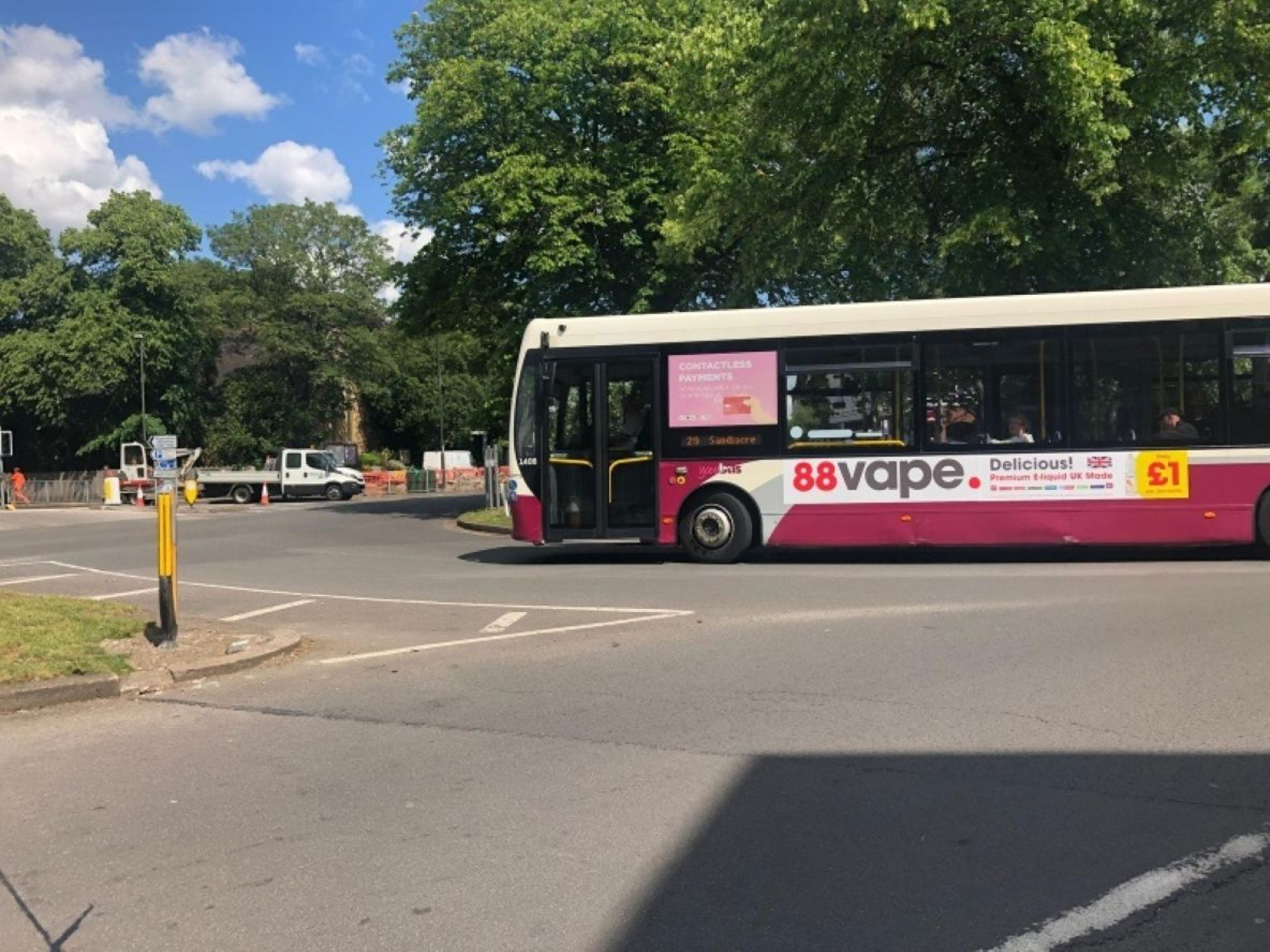
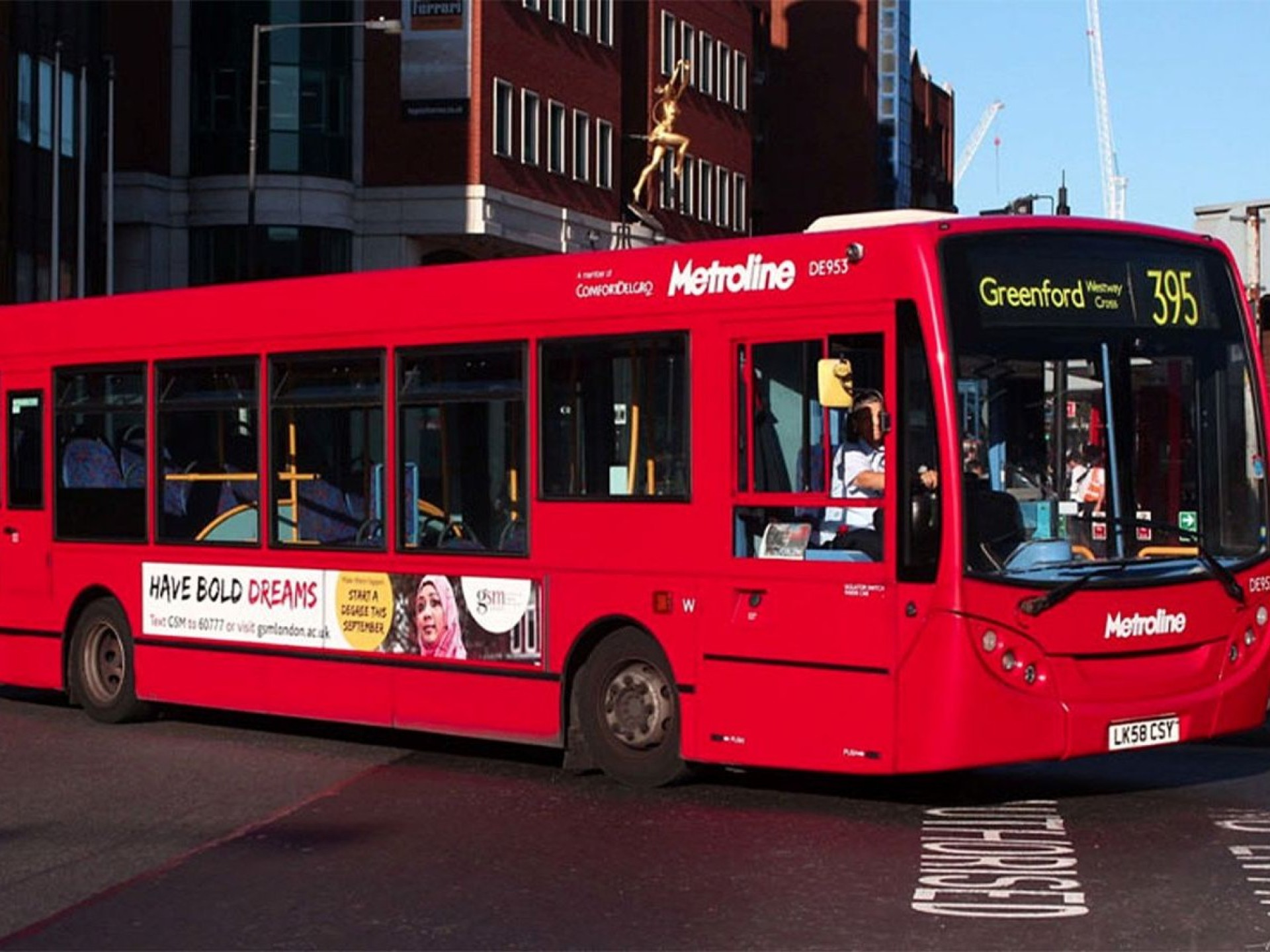
Single-Deck Sides Frequently Asked Questions
How much does it cost to advertise on a single-deck side?
Single-deck sides only cost on average £150 per panel for 2 weeks, making them an extremely cost-effective way of reaching audiences across local communities and city centres.
Is advertising on a single-deck side an effective form of bus advertising?
Yes, advertising on the side of a single-deck bus is a highly targeted, high-frequency method of reaching your target audience whilst they are in their local area. Having high-frequency and repeated exposures ensures that your brand message is absorbed and retained.
Double Deck Side
Placed on double-deck buses, these 20ft pavement-facing adverts are positioned high up, reaching above the clutter of busy streets and demanding attention from both pedestrians and motorists. The movement of a bus combined with the visibility of a double-deck side draws attention and delivers your advert at a high frequency throughout the day.
Double-deck sides have a significant presence in city centres ensuring your brand is seen in the right place at the right time. This strategic placement prompts impulse purchases on the high street, effectively capturing the attention of potential customers and driving consumer action.
Double-Deck Sides Frequently Asked Questions
How effective is double-deck side bus advertising?
Bus double-deck side advertising is highly effective when done well. It is important to have a simple and clear message. Artwork needs to be visually strong (high contrast and simple).
Can I advertise on double-deck sides in specific areas?
Double-deck side advertising is available in almost every city, town or village in the UK. We select buses based on the routes that they take on a daily basis. You can’t advertise on a specific bus number however, you can advertise on buses that cover a specific geographical area.
Double Deck T Sides
Double-deck T-Sides are the most recognisable high street bus format due to their unique shape and size, giving stature to a brand at a fraction of the production cost of TV or radio. With a strong visual presence, they command the attention of both pedestrians and motorists, allowing you to successfully communicate your message. T-Side advertising targets consumers on the driver’s side of the bus. The deep drop in the T is there as it fills the bus staircase- going to the top deck- therefore creating the T shape.
Bus double-deck T-Side advertising targets those out shopping - via mobile. Did you know that 94% of pedestrians now have smartphones? Having a strong high street presence means that T-Side advertising can lead to increased engagement and a clear path to purchase, prompting impulse purchases and driving consumers to your websites within seconds of seeing your advert. A national T-Side campaign delivers a huge audience comparable to that of a national TV broadcast campaign, making it one of the best solutions on the market for getting your brand seen in one fortnight.
Double-Deck T-Sides Frequently Asked Questions
How effective is T-Side bus advertising?
A two-week national campaign reaches 78% of all adults who all see the ad fourteen times over that two-week period (Source: BUSADS).
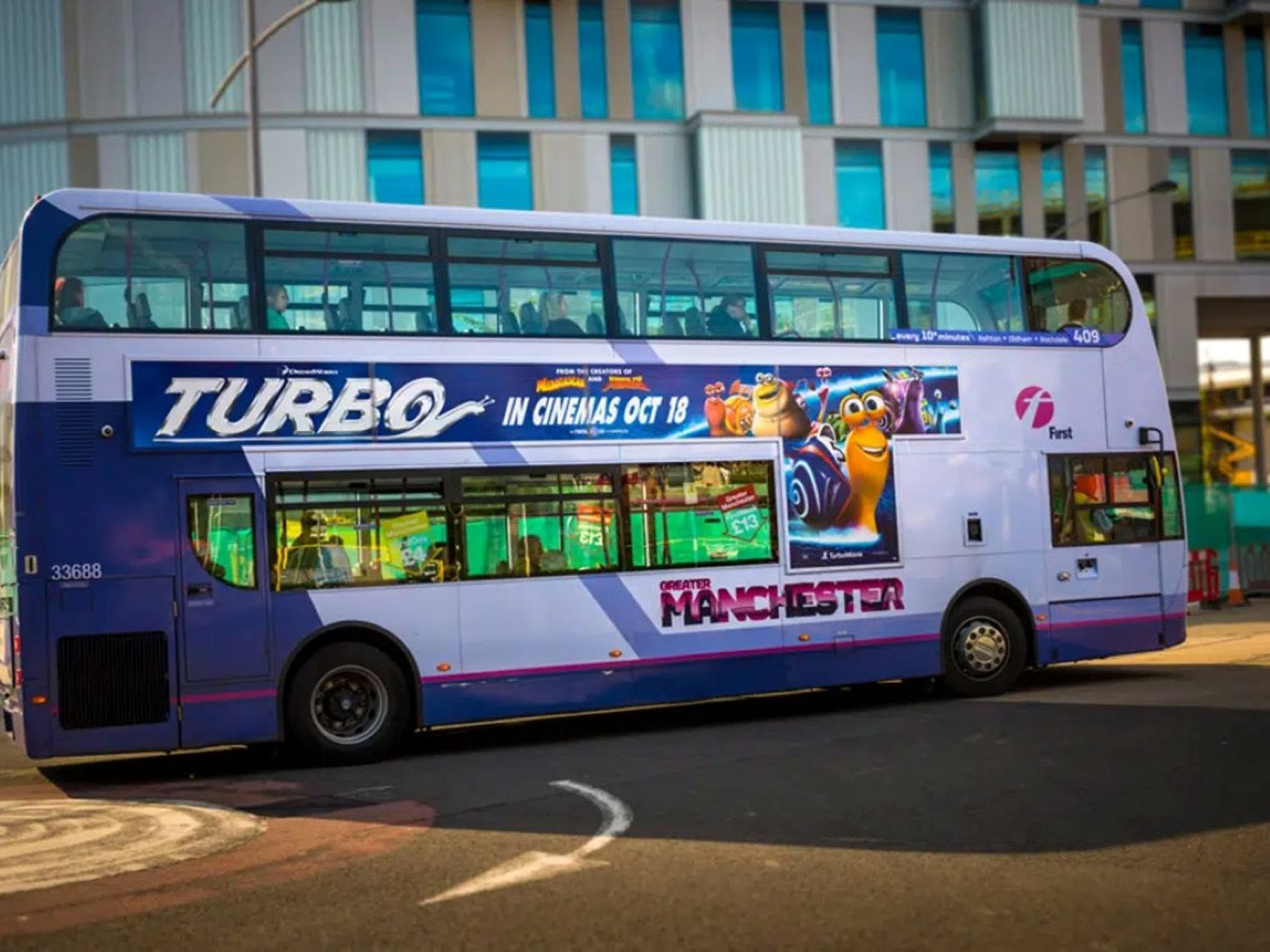
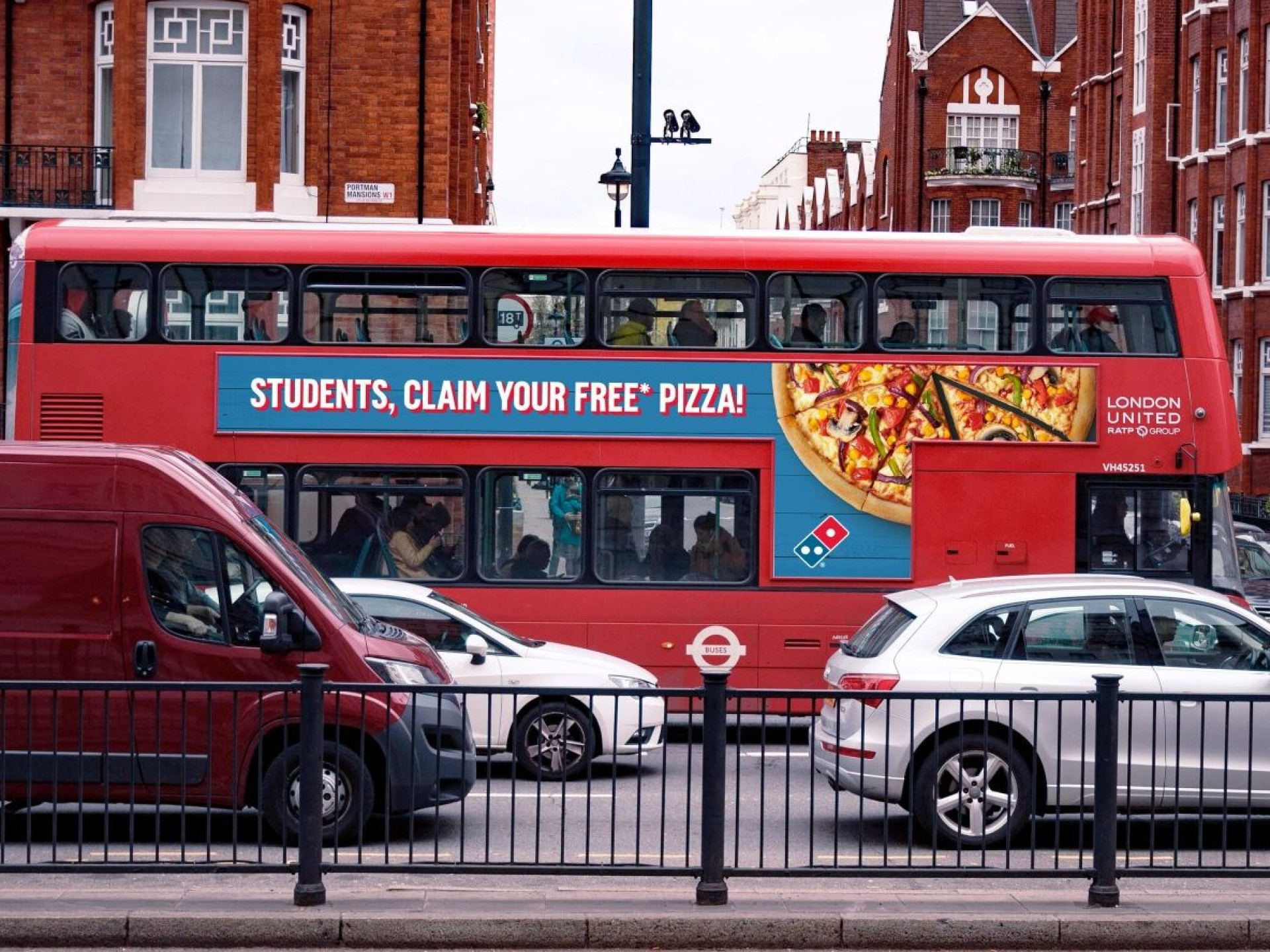
Mega Bus Rear Advertising
Big, bold and unmissable, Wrapped Bus Rears (Sometimes called Mega Rears) are a great creative canvas that will showcase your offer or service to pedestrians and in-car audiences. Wrapped Rears can be bought on both single-deck and double-deck buses.
Single-deck buses connect local communities, meaning your impactful campaign will reach consumers in the suburbs, close to their homes. Double-deck buses tend to spend more time in city centres, reaching active shoppers and commuters. 1 in 3 people in targeted cities recalled at least one Wrapped Bus Rear.
Wrapped Bus Rear comes down to its sheer size. Standing 4 metres high (more than twice the height of a roadside 6-sheet) means that a double deck Wrapped Rear will not be seen by and only grab the attention of the car behind but all the surrounding cars and pedestrians, maximising your impact. Bus rears have an average dwell time of 48 seconds, meaning that consumers are exposed to your ad for longer. This extended exposure gives the consumer more time to absorb the message and embed the advert details in their memory, encouraging a direct response. Wrapped Bus Rears are generally taken over a 6-to-12-month period as they act as a brand builder and a direct response tool for your message.
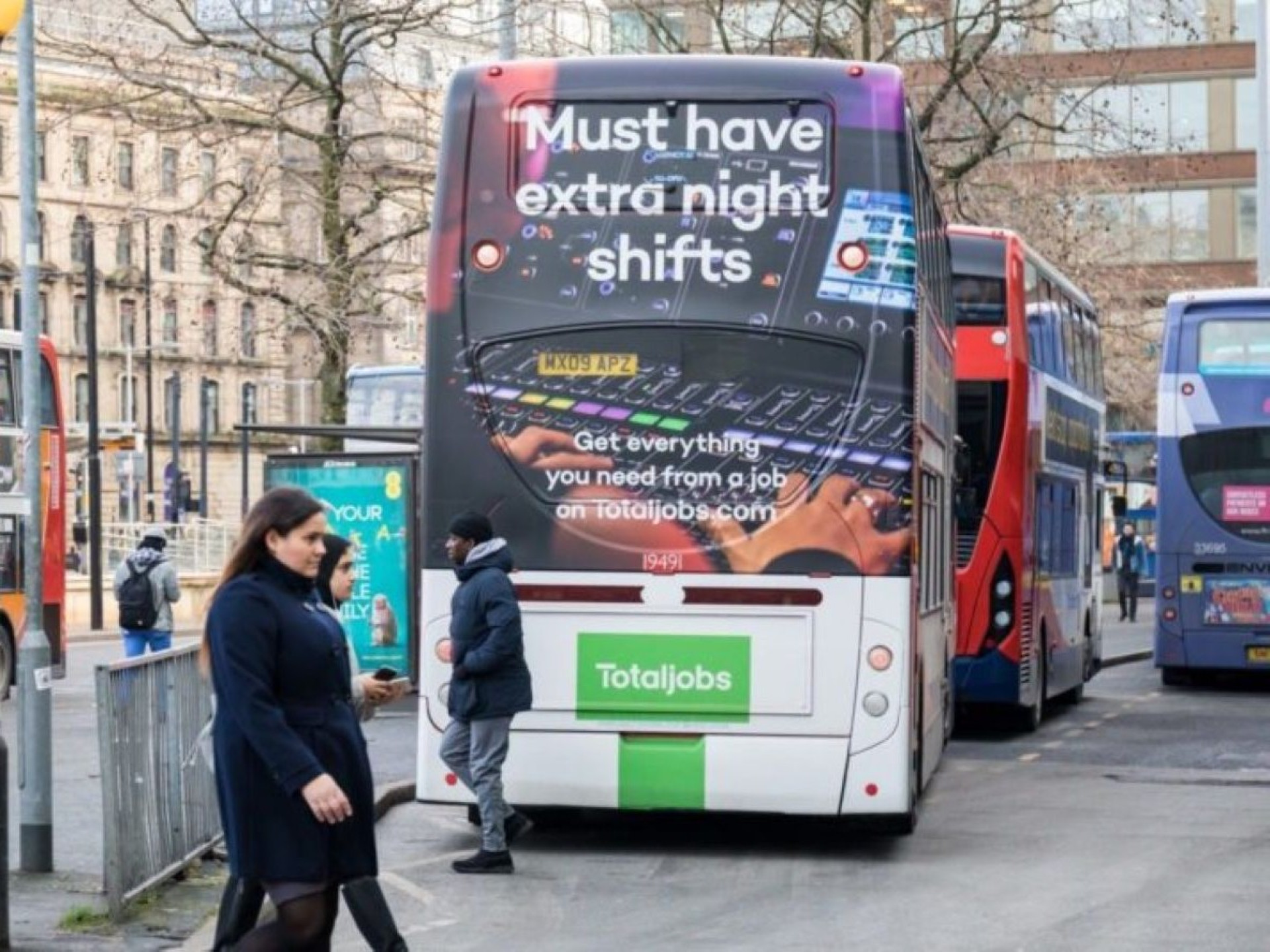
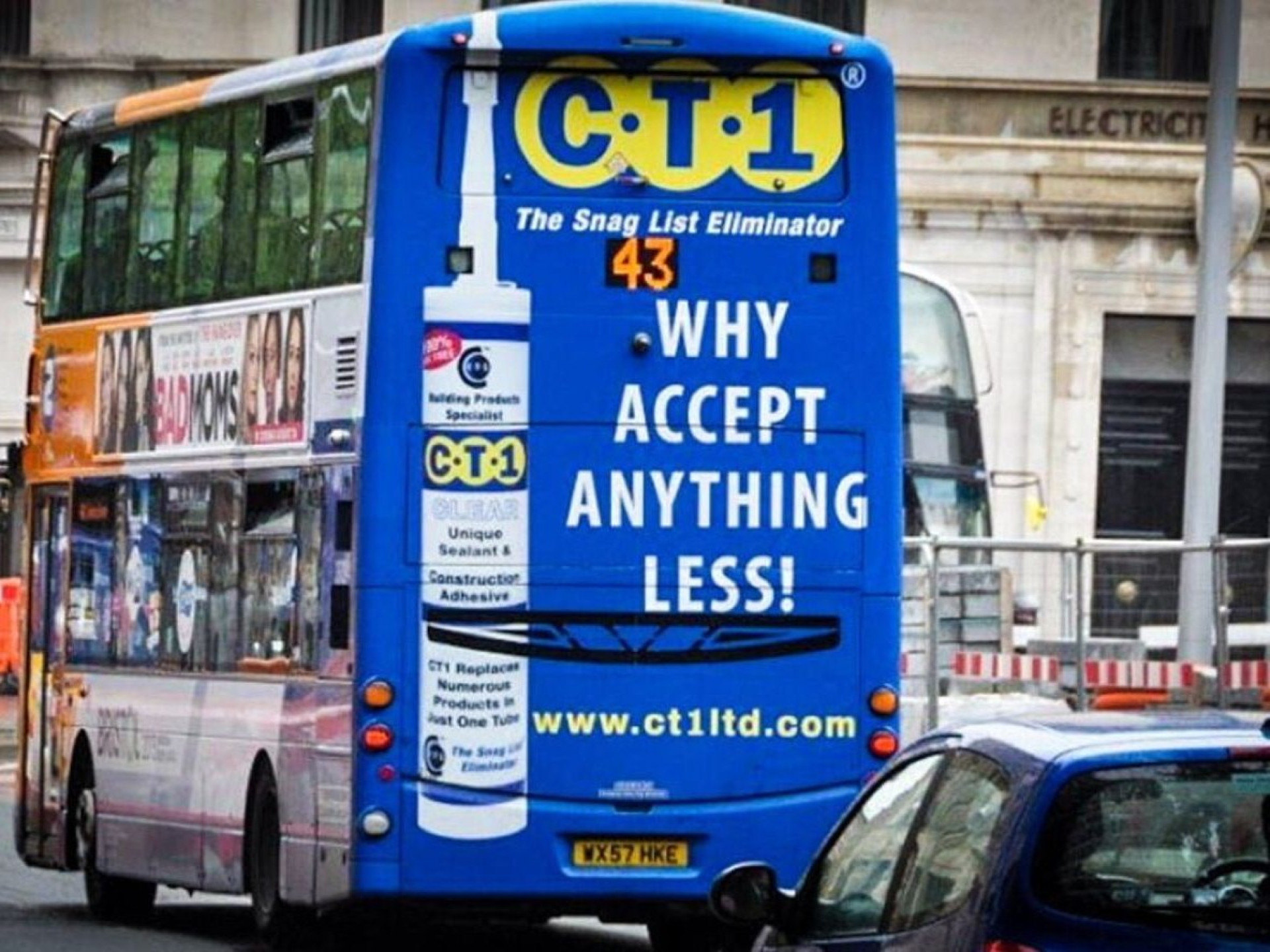
Wrapped Bus Rear Frequently Asked Questions
Who can I target with a Wrapped Bus Rear advertising campaign?
Nearby motorists cannot miss a Wrapped Bus Rear, and due to their huge size, they are more likely to be noticed by pedestrians than their lower counterparts.
How much does a Rear Bus Wrapping campaign cost?
Wrapping the rear of a bus costs approximately £2,000 per bus for the year. The media costs vary depending on the campaign's duration and the number of buses.
Can I advertise on a bus with a Wrapped Rear in specific areas?
Wrapped Rear Bus advertising is available in almost every UK city, town or village. We select buses based on the routes that they take daily. You can’t advertise on a specific bus number; however, you can advertise on buses that cover a specific geographical area.
Why should I choose a Bus Wrapped Rear Campaign?
Wrapped Bus Rear advertising gives you creative freedom – so your brand has the opportunity and freedom to create engaging, hard-working visuals to captivate your target audience and make sure your message is seen on a busy street. Wrapped Bus Rears have the capability to make your advertising campaign work to its maximum potential, being seen by motorists waiting in traffic, pedestrians on the high street, and passengers waiting for the bus.
Wrapped Bus Advertising
Wrapped buses literally drive brands and messages into the public domain, making them unmissable compared to other media formats. Who wouldn’t want to see their company brand wrapped around a bus? As one of the most visually stunning and impactful out-of-home (OOH) formats, wrapped buses generate the talkability and PR that all brands seek, allowing them to stand out even on the busiest of roads. Imagine the most engaging centre-spread ad you have ever seen in a magazine, but 20ft high and moving. Wrapped buses are simply show-stopping, with 78% of the public agreeing that they are not to be missed. This statistic not only highlights the impact they have on audiences but also how positively they resonate with people on the high street, making them a powerful tool for brand promotion.
Wrapped buses give a brand instant credibility and prominence. According to Social OOH, 71% of advertisers consider sharing standout OOH campaigns on social media, while 78% of the public agree that wrapping a bus is a great way to launch a brand. Another benefit of a wrapped bus is its route through busy city centers, often reaching areas where large roadside formats are scarce. Wrapped buses achieve a near 55/45 split between pedestrian and in-car audiences, making them perfect for all advertising objectives. This ensures your brand message is seen by a diverse audience, maximizing its reach and effectiveness, and creating a lasting impression on potential customers.
Wrapped Bus Frequently Asked Questions
Is wrapping a bus expensive?
Bus wrapping is the most expensive form of bus advertising. If you’re looking for a more cost-effective way to amplify your message and make a bold statement, you can simply leave the windows of the bus unwrapped or you could consider wrapping the rear of several buses.
How much does it cost to wrap a bus?
There are two charges when it comes to wrapping a bus. The first is the production cost, which depends upon whether you are wrapping a double-decked or single decked bus and whether or not you are wrapping the windows. The second charge is the cost of media which can be paid monthly- generally over a year to make it more cost-effective.
How effective is bus wrap advertising?
Bus wrapping is highly effective when done well, giving the advertiser a chance to be truly individual with a moving billboard right in the heart of the city. The large scale of the message and high distinctiveness ensures instant visibility and brand recognition. Bus advertising offers high levels of response with over 80% of the people who see bus advertisements responding to them (Source Route).
How do you design a bus wrap?
With our experience in designing bus wraps, we can help you stand out from the crowd. Talk to our design team about how best to utilise this unique format and ensure that your bus ad engages with your target audience.
